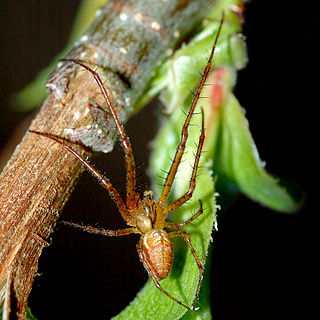
Long-jawed orb weavers or long jawed spiders (Tetragnathidae) are a family of araneomorph spiders first described by Anton Menge in 1866. They have elongated bodies, legs, and chelicerae, and build small orb webs with an open hub with few, wide-set radii and spirals with no signal line or retreat. Some species are often found in long vegetation near water.
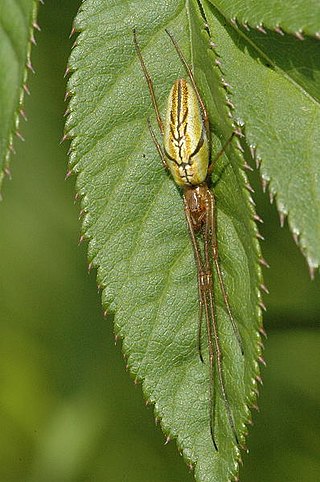
Tetragnatha is a genus of long-jawed orb-weavers found all over the world. It was first described by Pierre André Latreille in 1804, and it contains hundreds of species. Most occur in the tropics and subtropics, and many can run over water. They are commonly called stretch spiders in reference to their elongated body form and their ability to hide on blades of grass or similar elongated substrates by stretching their front legs forward and the others behind them. The name Tetragnatha is derived from Greek, tetra- a numerical prefix referring to four and gnatha meaning jaw. Evolution to cursorial behavior occurred long ago in a few different species, the most studied being those found on the Hawaiian islands. One of the biggest and most common species is T. extensa, which has a holarctic distribution. It can be found near lakes, river banks or swamps. Large numbers of individuals can often be found in reeds, tall grass, and around minor trees and shrubs.

Lake Tawakoni State Park is a state park located in Hunt County, Texas, United States, 11.2 miles (18.0 km) north of Wills Point. It is on the south central shore of Lake Tawakoni, a 37,879-acre reservoir on the Sabine River.

Tetragnatha extensa is a species of spider found across the Northern Hemisphere. It has an elongate body, up to 11 mm (0.43 in) long, and adopts a straight line posture when alarmed. It lives on low vegetation in damp areas, and feeds on flying insects which it catches in its web.
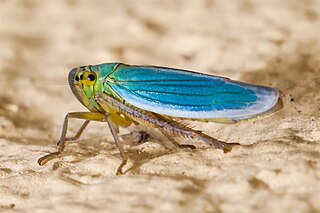
Cicadella viridis, the green leafhopper, is a species belonging to the subfamily Cicadellinae of the family Cicadellidae.
Tetragnatha foveata, is a species of spider of the genus Tetragnatha. It is native to Sri Lanka, Laccadive Islands, and Maldives.
Tetragnatha geniculata, is a species of spider of the genus Tetragnatha. It is endemic to Sri Lanka.
Tetragnatha planata, is a species of spider of the genus Tetragnatha. It is endemic to Sri Lanka.
Tetragnatha tenera, is a species of spider of the genus Tetragnatha. It is found in India, Sri Lanka and Queensland.
Tetragnatha virescens is a species of spider of the genus Tetragnatha. It is found in Bangladesh, Sri Lanka to Indonesia, and Philippines. The species is more commonly found during the early vegetative growth stage of the rice plant, where they are important predators. Male is about 5.9 to 7.8 mm in length without chelicerae. Anterior row of eyes occupying the full width of carapace. Maxilla are nearly parallel. All legs with spines and hair. Female is larger than male, usually about 6.55 to 8.25 mm in length. Body is light green in color, which is suitable for the survival among paddy leaves.

Tetragnatha montana, commonly known as the silver stretch spider, is a species of long-jawed orb weaver from the family Tetragnathidae that has a Palearctic distribution. It preys mostly on flies and mosquitoes. The name silver stretch spider refers to its shiny metallic colour and its habit of extending its legs into a stick like shape.
Tetragnatha guatemalensis, the Guatemalan long-jawed spider, is a species of long-jawed orb weaver in the family Tetragnathidae. It is found in North, Central America, Cuba, and Jamaica. Under certain conditions, such as mass emergence of midges, the spiders will weave communal webs.
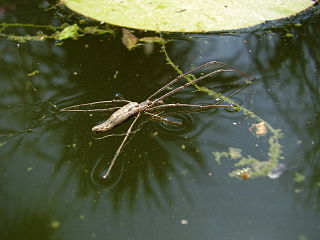
Tetragnatha laboriosa, the silver longjawed orbweaver, is a species of long-jawed orb weaver in the spider family Tetragnathidae. It is found in North and Central America. T. laboriosa goes through nine instars, including its adult stage. The spiders are predominantly crepuscular, with nocturnal mating habits.
Tetragnatha caudata is a species of long-jawed orb weaver in the family of spiders known as Tetragnathidae. It is found in North, Central America, Cuba, and Jamaica.
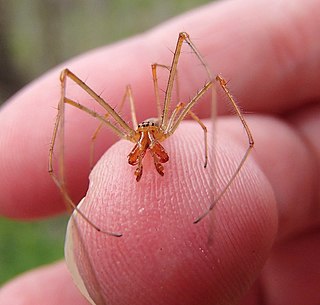
Tetragnatha versicolor is a species of long-jawed orb weaver in the spider family Tetragnathidae. It is found throughout North America, Canada, Central America, and Cuba, but are most common in the United States. T. versicolor is heavily concentrated in New England and the west coast in states like California and Washington. T. versicolor is considered a habitat generalist, and can thrive in many different environments. While they can be found in places like Grasslands, Wetlands, Forests, etc., they prefer dryer areas like normal trees and shrubs. Unlike other spiders in the genus Tetragnatha, T. versicolor will rarely reside near aquatic environments. T. versicolor will typically be colored dark yellow or pale orange and average around 5 mm for males and 6.5 mm for females in length, which is very small for a spider. They are much longer than they are wide, making them very distinct. In addition, T. versicolor can be distinguished from other spiders in Tetragnatha by the distinct separation of the anterior/posterior eyes and the appearance of their reproductive organs. As an orb weaver spider, T. versicolor creates a web to hunt for prey. It will wait at night for prey to stumble into its web and use vibrational signals throughout the web to sense trapped prey. In terms of mating behavior, T. versicolor lacks a distinct courting ritual and will mate with any others in the proximity. Mating behavior is heavily affected by female mating history. In terms of interactions with humans, the bite of T. versicolor is venomous, but not known to cause significant harm.

Tetragnatha straminea is a species of long-jawed orb weaver in the spider family Tetragnathidae. It is found in the United States, Canada, and Cuba.

Tetragnatha nitens is a species of long-jawed orb weaver in the spider family Tetragnathidae. It is found in Asia, has been introduced into the Americas, Madeira, Canary Islands, Europe, Egypt, Madagascar, Pacific islands, and New Zealand.

Tetragnatha mandibulata is a species of long-jawed orb-weaver spider in the family Tetragnathidae. It was first described by Walckenaer in 1841. The species is widespread and occurs in western Africa, southern and eastern Asia, and Australia.

Tawhai is a monotypic genus of Polynesian long-jawed orb-weavers containing the single species Tawhai arborea. The genus was first described by A. Álvarez-Padilla, R. J. Kallal and Gustavo Hormiga in 2020, and it has only been found in New Zealand. The type species, Tawhai arborea, was originally described under the name "Tetragnatha arborea".













